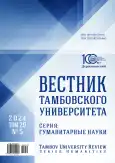Demographic profile of the “revolutionary turning point” generation of the Russian village in the first half of the 1920s
- Authors: Ippolitov V.A.1, Bezgin V.B.1
-
Affiliations:
- Tambov State Technical University
- Issue: Vol 29, No 5 (2024)
- Pages: 1458-1470
- Section: NATIONAL HISTORY
- URL: https://journal-vniispk.ru/1810-0201/article/view/297677
- DOI: https://doi.org/10.20310/1810-0201-2024-29-5-1458-1470
- ID: 297677
Cite item
Full Text
Abstract
Importance. The demographic portrait of peasantry in the first half of the 1920s is examined. The relevance of the study is due to the need for a comprehensive study of the Russian peasantry of the “revolutionary turning point” generation (born at the turn of the 19th and 20th centuries). The pur pose of the research is to provide a detailed demographic description of the specified age cohort of rural society during a period of large-scale socio-political upheavals.Materials and Methods. The authors focus on the main demographic indicators: birth rate, mor tality, marriage rate, and natural population growth. In order to determine the factors that influ enced the model of demographic behaviour of peasants, statistical collections for the Voronezh, Oryol, Kursk, and Tambov provinces are analysed. These sources are characterised by the pres ence of objective data on the population with minimal ideological distortions. The paper uses a wide range of materials based on censuses, surveys, special studies, and observations. The works of prominent ethnographers of the 1920s are also considered.Results and Discussion. The authors have analysed the demographic behaviour of the “revolu tionary turning point” generation during the new economic policy period. The influence of wars and revolutions on the family behaviour of peasants is studied. The features of marriage and di vorce are considered. The specifics of compensatory birth rate after a series of wars are examined. The main causes of mortality among peasants of the “revolutionary turning point” generation are established. The factors increasing life expectancy and decreasing the mortality rate of the rural population have also been determined.Conclusion. Based on a wide range of sources, the conclusion is made about the contradictory model of demographic behaviour of peasants of this generation, which combined elements of tra ditionalism and modernist features.
About the authors
V. A. Ippolitov
Tambov State Technical University
Email: vladimir.ippolitov@mail.ru
ORCID iD: 0000-0001-9327-3865
Cand. Sci. (History), Senior Research Scholar of Science Research Laboratory “Communication aspects of historical and socio-economic development of society”
106/5 Sovetskaya St., Tambov, 392000, Russian FederationV. B. Bezgin
Tambov State Technical University
Author for correspondence.
Email: vladyka62@mail.ru
ORCID iD: 0000-0002-7074-6823
Dr. Sci. (History), Professor, Leading Research Scholar of Science Research Laboratory “Communication aspects of historical and socio-economic development of society”
106/5 Sovetskaya St., Tambov, 392000, Russian FederationReferences
- Esikov S.A. (2004). Krest’yanskoe khozyaistvo Tambovskoi gubernii v gody nehpa (1921–1928 gg.). Tambov, Tambov State Technical University Publ., 126 p. (In Russ.) https://elibrary.ru/qqemsn
- Davydov D.V. (2010). Krest’yanstvo TASSR v usloviyakh nehpa: istoriko-demograficheskaya kharakteristika. Kazan, Kazan National Research Technological University Publ., 227 p. (In Russ.) https://elibrary.ru/qpuzoj
- Zhiromskaya V.B. (2018). Demographic characteristics of the gainfully employed population of the RSFSR in the 1920s – mid-1930s. Obshchestvo: filosofiya, istoriya. Kul’tura = Society: Philosophy, History, Culture, no. 4, pp. 66-70. (In Russ.) https://doi.org/10.24158/fik.2018.4.14, https://elibrary.ru/yvqvrx
- Isupov V.A. (2000). Demograficheskie katastrofy i krizisy v Rossii v pervoi polovine XX veka. Novosibirsk, Sibirskii khronograf Publ., 244 p. (In Russ.) https://elibrary.ru/tzvtfp
- Romanov R.E. (2017). “Children of nep”: young workers of the Siberian rear as an economic and demographic phenomenon (1920s – first half of the 1940s). Istoriko-ehkonomicheskie issledovaniya = Journal of Economic History & History of Economics, vol. 18, no. 1, pp. 127-151. (In Russ.) https://doi.org/10.17150/2308-2588.2017.18(1).127-151, https://elibrary.ru/yjvzov
- Shanin T. (2005). Istoriya pokolenii i pokolencheskaya istoriya. Chelovek. Soobshchestvo. Upravlenie, no. 3, pp. 6-25. (In Russ.) https://elibrary.ru/olbgbq
- Bezgin V.B. (2023). Peasant children and adolescents in the agrarian protests of 1905–1907. Krest’yanovedenie = Russian Peasant Studies, vol. 8, no. 3, pp. 63-77. (In Russ.) https://doi.org/10.22394/2500-1809-2023-8-3-63-77, https://elibrary.ru/fjgxjm
- Ippolitov V.A. (2023). The revolution of 1905–1907 in the Tambov Gubernia peasants’ memoirs. Vestnik arkhivista = Herald of an Archivist, no. 3, pp. 726-738. (In Russ.) https://doi.org/10.28995/2073-0101-2023-3-726-738, https://elibrary.ru/naivdg
- Vyazinkin A.Yu., Yakimov K.A. (2022). Peasant traditionalism during the era of the “revolutionary turning point”. Vestnik Tambovskogo universiteta. Seriya: Gumanitarnye nauki = Tambov University Review. Series: Humanities, vol. 27, no. 5, pp. 1296-1303. (In Russ.) https://doi.org/10.20310/1810-0201-2022-27-5-1296-1303, https://elibrary.ru/carsng
- Slezin A.A. (2023). Intergenerational rift in Russian village: impact of “anti-religious offensive” of communist youth at turn of the 1920–1930s. Nauchnyi Dialog, vol. 12, no. 3, pp. 446-477. (In Russ.) https://doi.org/10.24224/2227-1295-2023-12-3-446-477, https://elibrary.ru/qfjfcd
- Pushina L.Yu. (2011). Generation as socio-cultural community. Vestnik Nizhegorodskogo universiteta im. N.I. Lobachevskogo. Seriya: Sotsial’nye nauki = Vestnik of Lobachevsky State University of Nizhni Novgorod. Series: Social Sciences, no. 3 (23), pp. 28-34. (In Russ.) https://elibrary.ru/phdcqv
- Zhiromskaya V.B. (2012). Osnovnye tendentsii demograficheskogo razvitiya Rossii v XX veke. Moscow, Kuchkovo pole Publ., 320 p. (In Russ.) https://elibrary.ru/rvbgrh
- Murin V.A. (1926). Byt i nravy derevenskoi molodezhi. Moscow, Novaya Moskva Publ., 158 p. (In Russ.)
- Polyakov Yu.A. (executive ed.) (2000). Naselenie Rossii v XX veke: Istoricheskie ocherki v 3 t. Moscow, t. 1, 463 p. (In Russ.)
- Bol’shakov A.M. (1927). Derevnya: 1917–1927. Moscow, Rabotnik prosvetleniya Publ., 472 p. (In Russ.)
- Bezgin V.B. (2010). Detoubiistvo i plodoizgnanie v russkoi derevne (1880–1920-e gg.). Pravo i politika = Law and Politics, no. 5, pp. 972-977. (In Russ.) https://elibrary.ru/lwqprp
Supplementary files









